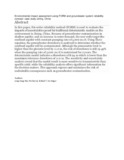| dc.contributor.author | Shu, Long Cang | |
| dc.contributor.author | Liu, Pei Gui | |
| dc.contributor.author | Ongor, Iro | |
| dc.date.accessioned | 2021-06-10T13:47:02Z | |
| dc.date.available | 2021-06-10T13:47:02Z | |
| dc.date.issued | 2007-09-20 | |
| dc.identifier.uri | https://doi.org/10.1007/S00254-007-1016-Z | |
| dc.identifier.uri | https://link.springer.com/article/10.1007/s00254-007-1016-z | |
| dc.identifier.uri | http://r-library.mmust.ac.ke/123456789/1694 | |
| dc.description.abstract | In this paper, fist-order reliability method (FORM) is used to evaluate the impacts of uncertainties posed by traditional deterministic models on the environment in Jining, China. Because of groundwater contamination in shallow aquifer, and an increase in water demand, the new wells target the confined aquifer with constant pumping rate of 5,000 m3/d. Using Theis equation, the groundwater drawdown is analyzed to determine whether the confined aquifer will be contaminated. Although the piezometric level is higher than the phreatic level by 11.0 m, the risk of drawdown is still 19.49% when the pumping rate of 5,000 m3/d is maintained for 2 years. The deterministic model indicates a drawdown of 8.94 m which is lower than the maximum tolerance drawdown of 11.0 m. The sensitivity and uncertainty analysis reveal that the model result is more sensitive to transmissivity than specific yield, while the reliability analysis offers significant information for the decision makers. This approach exposes and minimizes the risk of undesirable consequences such as groundwater contamination. | en_US |
| dc.language.iso | en | en_US |
| dc.publisher | Environmental Geology | en_US |
| dc.subject | Environmental, impact, assessment, FORM , groundwater, system, reliability,concept | en_US |
| dc.title | Environmental impact assessment using FORM and groundwater system reliability concept | en_US |
| dc.title.alternative | case study Jining, China | en_US |
| dc.type | Article | en_US |

